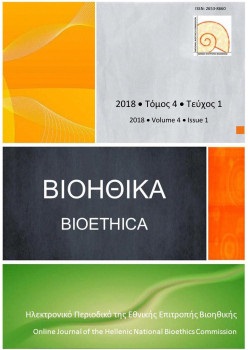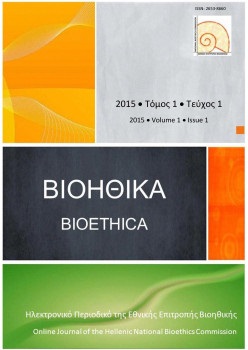Το νομοθετικό πλαίσιο της μεταθανάτιας γονιμοποίησης σε Ελλάδα και Σουηδία
Аннотация
Η μεταθανάτια γονιμοποίηση είναι μία από τις πιο αμφιλεγόμενες μεθόδους ΙΥΑ, η εφαρμογή της οποίας εγείρει πλήθος νομικών, θρησκευτικών, ηθικών και κοινωνικών ενδοιασμών. Για το λόγο αυτό και η εξέταση του ζητήματος χρήζει ιδιαίτερης προσοχής, καθώς ο νομοθέτης έρχεται αντιμέτωπος με πρωτόγνωρες προκλήσεις. Η συγκεκριμένη εφαρμογή κατέστη δυνατή λόγω της δυνατότητας κρυοσυντήρησης γαμετών, αλλά και γονιμοποιημένων ωαρίων.
Πλήθος επιχειρημάτων έχει αναπτυχθεί τόσο υπέρ όσο και κατά αυτής της ειδικής μορφής αναπαραγωγικής τεχνικής. Σύμφωνα με την ελληνική νομοθεσία είναι επιτρεπτή ηpostmortem τεχνητή γονιμοποίηση με την προϋπόθεση ότι τηρούνται συγκεκριμένες αυστηρές προϋποθέσεις που προβλέπονται από το ρυθμιστικό πλαίσιο. Η μη συμμόρφωση μάλιστα με τις νομοθετικές επιταγές συνεπάγεται ς αντίστοιχες συνέπειες που μπορεί να είναι αστικής, ποινικής και διοικητικής φύσης. Αντίθετα, ο Σουηδός νομοθέτης επέλεξε την απαγόρευση της μεταθανάτιας γονιμοποίησης καθώς βασική προϋπόθεση τέλεσης εφαρμογών ΙΥΑ είναι οι δότες του γεννητικού υλικού να είναι ζωντανοί. Αυτός ο περιορισμός αποκλείει ακόμη και τη χρήση κρυοσυνητρημένου γονιμοποιημένου ωαρίου μετά το θάνατο του συζύγου/συντρόφου.
Ωστόσο, έχει αναπτυχθεί ζωηρή συζήτηση στη Σουηδία για το αν θα πρέπει να επιτραπεί η μεταθανάτια γονιμοποίηση στις περιπτώσεις που η εφαρμογή κάποιας μεθόδου υποβοήθησης της αναπαραγωγής έχει ξεκινήσει πριν το θάνατο του πατέρα ή της μητέρας. Σε κάθε περίπτωση απαιτείται να είναι πλήρως διασαφηνισμένα όλα τα θέματα που αναφύονται προκειμένου να υπάρχει ασφάλεια δικαίου και τα παιδιά που γεννιούνται μέσω αυτής της τεχνικής να είναι πλήρως κατοχυρωμένα απολαμβάνοντας τα δικαιώματα που απολαμβάνουν και τα υπόλοιπα παιδιά που γεννήθηκαν είτε με φυσικό τρόπο είτε με τη χρήση κάποιας άλλης μορφής ΙΥΑ.
Article Details
- Как цитировать
-
Κηπουρίδου (Kalliopi Kipouridou) Κ., & Μιλαπήδου (Maria Milapidou) Μ. (2018). Το νομοθετικό πλαίσιο της μεταθανάτιας γονιμοποίησης σε Ελλάδα και Σουηδία. Bioethica, 4(1), 55–67. https://doi.org/10.12681/bioeth.19698
- Выпуск
- Том 4 № 1 (2018): Bioethica
- Раздел
- Original Articles
Authors who publish with this journal agree to the following terms:
- Authors retain copyright and grant the journal right of first publication with the work simultaneously licensed under a Creative Commons Attribution CC BY 4.0 License, which allows for immediate free access to the work and permits any user to read, download, copy, distribute, print, search, or link to the full texts of articles, crawl them for indexing, pass them as data to software, or use them for any other lawful purpose. Appropriate credit must be given by citing the author(s) and the original publication in this journal.
- Authors are able to enter into separate, additional contractual arrangements for the non-exclusive distribution of the journal's published version of the work (e.g. post it to an institutional repository or publish it in a book), with an acknowledgement of its initial publication in this journal.
We encourage authors to deposit their articles, as well as data underlying the publications, in institutional and/or other appropriate subject repositories.
Bioethica permits and encourages authors to archive the final publication pdf in institutional (e.g. the repository of the National Hellenic Research Foundation) or other appropriate subject repositories (e.g. SSOAR repository for social sciences), in compliance with institutional and/or funder open access policies, after publication in the BIOETHICA. Authors must provide bibliographic details that credit publication in the journal, as well as related funding details (when applicable).
Lists of institutional and other subject-based academic open access repositories can be found listed by country at the registry http://opendoar.org/countrylist.php
If your institution does not possess a repository you may deposit a copy of your paper at no cost with www.zenodo.org , the repository supported for open access research in the EU by the European Commission, through the project OpenAIRE (www.openaire.eu )




